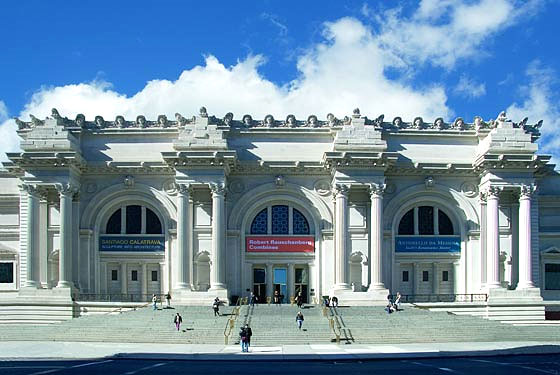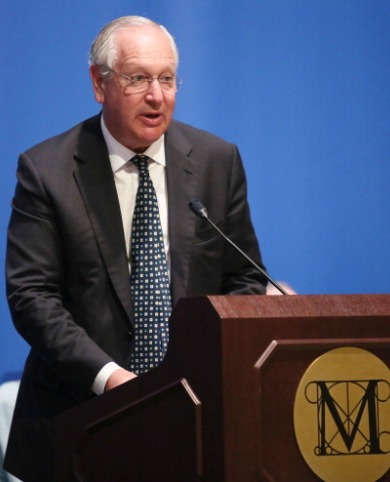As I indicated in yesterday’s post, the Metropolitan Museum of Art* is in for a bit of a rough patch–but let’s not overdo it (as some people have). The Met’s exhibitions program–its core–is still packed with excellent offerings. Great curators still want to work for the Met–or will, once things settle down. It goes without saying that its collections are the best in the land.
 But the Met has gone wrong in not playing to its strengths. Supposedly pulled by moneyed trustees who collect contemporary art and–this must be said–definitely by many critics and others in the media pushing in the same direction, Tom Campbell has tried to make the Met more contemporary.
But the Met has gone wrong in not playing to its strengths. Supposedly pulled by moneyed trustees who collect contemporary art and–this must be said–definitely by many critics and others in the media pushing in the same direction, Tom Campbell has tried to make the Met more contemporary.
Let me say right here that I have nothing against contemporary art: I like a lot of it.
But no one complains that the Louvre has missed the boat on contemporary art; no one says the Louvre can’t expect to draw crowds unless it updates its offerings. In 2015, 8.6 million people visited the Louvre, even though there they don’t even see Impressionism or other 19th century art (according to statistics compiled by The Art Newspaper). That is the province of the Musee d’Orsay. And if in Paris you want to see contemporary art, you go to the Pompidou Center. It had 3 million visitors in 2015. The Orsay, by the way, had 3.4 million.
Likewise, no one says the National Gallery in London or the British Museum must move foursquare into contemporary. The National Gallery attracted 5.9 million people in 2015, and the British Museum 6.8 million. Both outdrew the Tate, with 4.7 million, just as here the Met (6.5 million) outdraws the Museum of Modern Art (3 million).
You can say that most of those visitors are tourists. Fair enough. And maybe some are going simply to see the Mona Lisa in Paris or the Raphaels, Titians, etc. at the National Gallery. Â But such people will always exist. And museums are not just about the numbers–they are also about the experience, the stimulation, the uplift, the internal, often inexpressible reaction that people have to great art. Yes, I know, museums are also social–but they can’t be only social experiences or they lose their raison d’etre (and maybe tax status).
Now I’m not letting Tom Campbell off the hook–if he was pushed by trustees, he also put many of those contemporary collectors on the museum’s board. He recruited them. (I cannot account for the media influence, but I am guessing it was far from nil.)
Board composition must therefore also be on the reform agenda. Many collectors still buy beyond contemporary–some collect contemporary AND. Let the Met find them and give them voice.
 Which brings me to the subject of board leadership. Daniel Brodsky has been chair since 2011. At the time he was elected, he told The New York Times that “he did not have a deep knowledge of art history or a favorite piece in the museum’s collection, although he prefers modern art.”
Which brings me to the subject of board leadership. Daniel Brodsky has been chair since 2011. At the time he was elected, he told The New York Times that “he did not have a deep knowledge of art history or a favorite piece in the museum’s collection, although he prefers modern art.”
He was also said to “get along with everybody.” That’s a great trait–until courageous action is required. It is, I’ve been told, a reason Brodsky did not attempt to remove Campbell before now. If he had, some damage may have been avoided. And he had to be pushed, my sources say, mainly by Hamilton (Tony) James, the finance committee chair, to act now.
These are the people on the executive committee:Â Candace K. Beinecke; Russell L. Carson; Richard L. Chilton, Jr.; Jeffrey W. Greenberg; J. Tomilson Hill; Hamilton E. James; Bonnie J. Sacerdote; Alejandro Santo Domingo; Andrew M. Saul; James E. Shipp, and Lulu C. Wang. These are the people we will have to look to most to safeguard the Met.
Chilton, btw, heads the nominating committee–I hope they he will help recruit trustees who are not only contemporary collectors to the board.
But back to what the Met should do: New York is just as big a cornucopia for art as Paris or London. I believe the museums here should emphasize their uniqueness, not blur the lines among them–so that the public does not where to expect what, where an exhibition of an artist is likely to be.
Museums thrive when they have distinct identities, not when they are shopping-mall mishmashes.
And what should the Met specialize in? It’s a universal museum, for sure, and should remain so. It should not be specialize in periods as do the Louvre and the National Gallery. But perhaps it should specialize in what, for lack of a better word, can be called canonical art. Art, even art of today, that will most likely be considered as part of the canon 100 years from now. Does that mean it will not show some hot artists that get a show in Chelsea? Yes, it does. But it doesn’t mean that it would not have shown Kerry James Marshall. He is likely to last.
The Met will miss some artists this way–but it already has and it always will. No curator is infallible, and neither can the Met be.
This doesn’t mean that the Met will ossify. The Met can and should still have digital programs, for example. It should still devise innovative ways to show great art. It should still educate visitors and students. It can and should experiment. But let’s rebalance. Let’s move away from the idea that contemporary art is the only entry point for “the masses.” How elitist.
*I consult to a foundation that supports the Met.
